-
Als sterren aan de hemel staan
Vandaag vinden er twee bijzondere astronomische verschijnselen plaats. Ten eerste is er de winterzonnewende, de kortste dag van het jaar. Hierdoor kwam de zon vanochtend precies op tussen de pylonen van de Amontempel in Karnak, alvorens zijn licht te schijnen op de tempel van Deir el-Bahari aan de overkant van de Nijl.
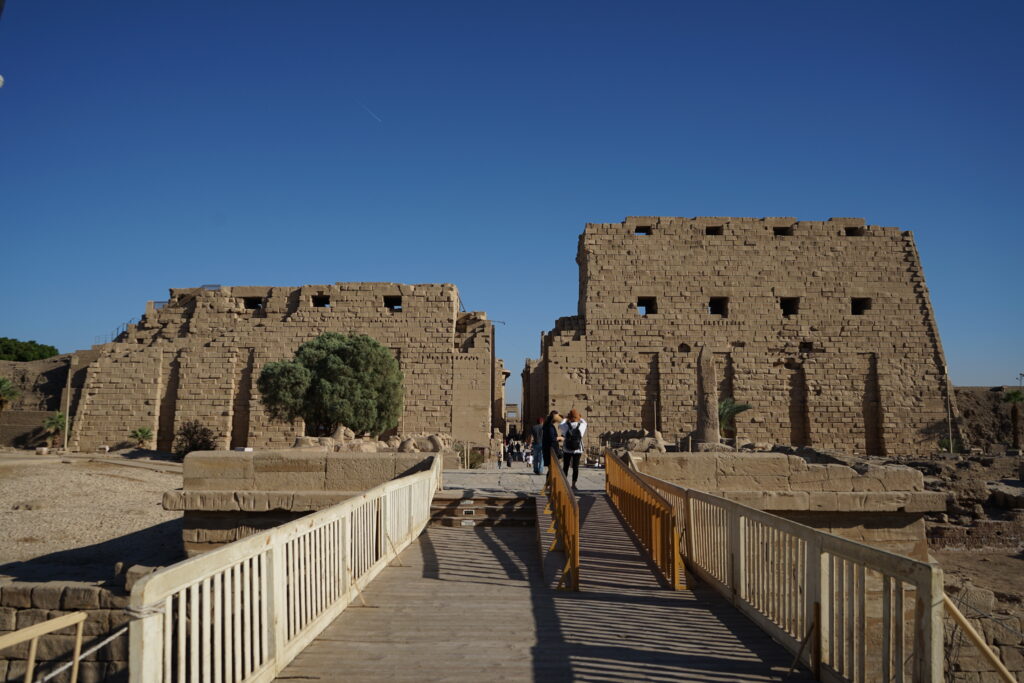
De tempel van Karnak in Luxor
Daarnaast is vanavond iets na zonsondergang voor het eerst in 800 jaar de ‘Grote Conjunctie’ te zien. De planeten Jupiter en Saturnus schuiven optisch zo dicht tegen elkaar dat een heldere ‘kerstster’ ontstaat. Was dit misschien hetzelfde fenomeen als uit het kerstverhaal?
Toen Jezus geboren was in Betlehem in Judea, tijdens de regering van Herodes, kwamen er magiërs uit het Oosten in Jeruzalem aan. Ze vroegen: “Waar is de pasgeboren koning van de Joden? Wij hebben namelijk zijn ster zien opgaan en zijn gekomen om hem eer te bewijzen.”
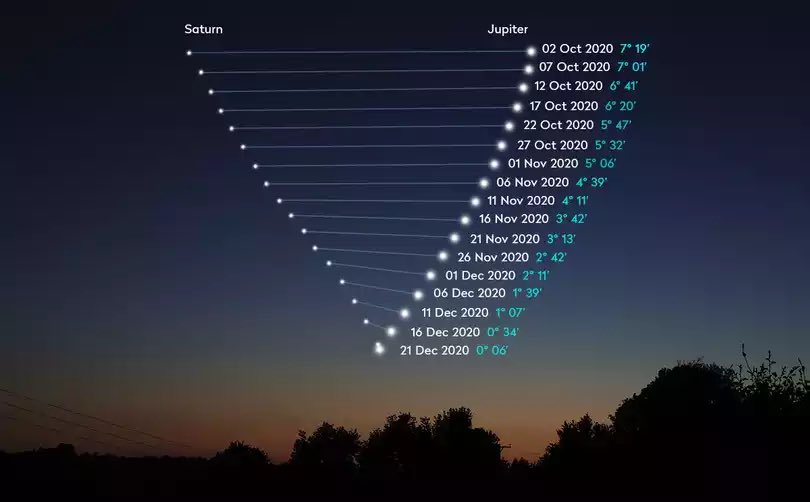
De Grote Conjunctie van Jupiter en Saturnus (bron)
De Oude Egyptenaren gebruiken astronomie om belangrijke bouwwerken te plaatsen en de kalender in de gaten te houden. Zo wisten ze wanneer de Nijl ging overstromen en er belangrijke festivals voor de goden moesten plaatsvinden. Priesters verbonden aan de tempel van Karnak gebruikten het dak van de tempel om waarnemingen te doen. Tempels en tombes bevatten astronomische plafonds met sterrenkaarten.
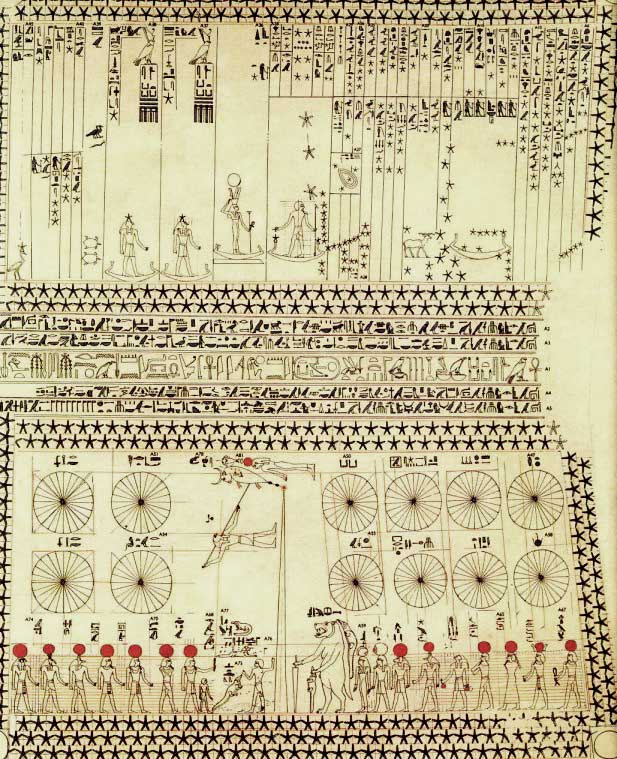
Het astronomische plafond in het graf van Senenmut (Wikimedia)
-
Lezingen in januari
NB: Deze lezingen worden aangeboden door externe partijen. Indien de lezing niet gratis is worden de kosten erbij vermeld.
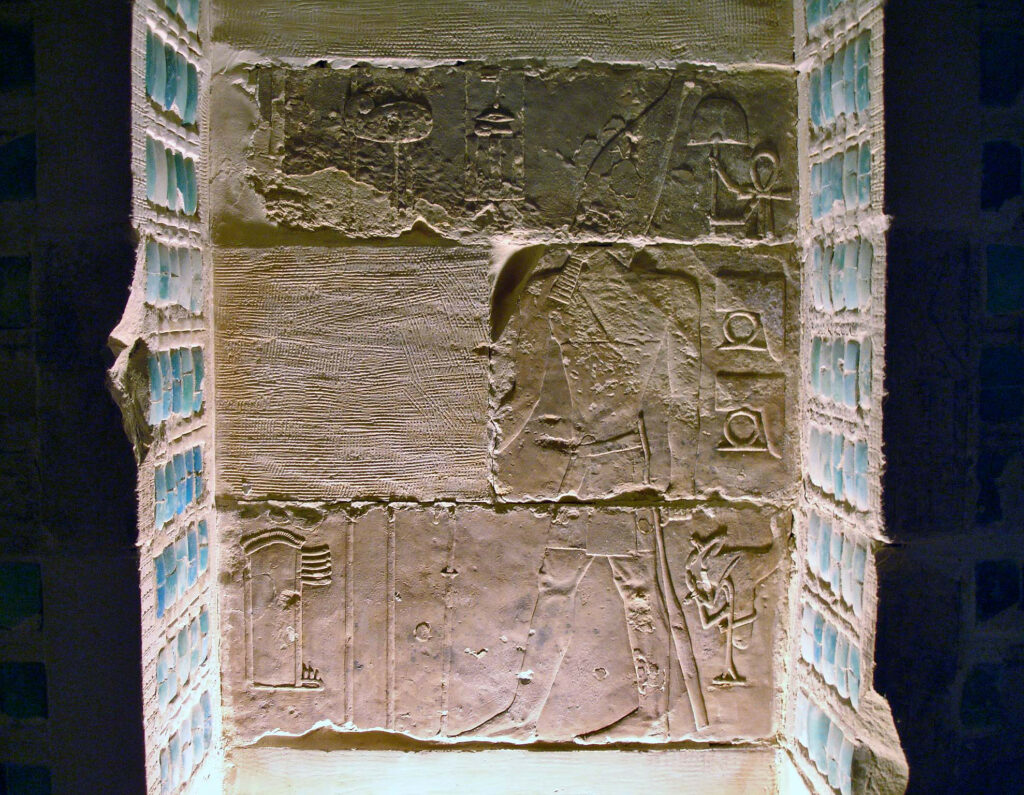
Gesteine im Alten Ägypten. Ihre Verwendung und Wertung
Donderdag 7 januari, 18.15 uurSpreker: John Baines (Oxford)
The cemeteries of Amarna: New perspectives on life under Akhenaten
Dinsdag 12 januari, 11.00 uurThe study of Amarna’s non-elite cemeteries is providing a wealth of new information on what it was like to live at Amarna during Akhenaten’s reign. This talk will present a summary of the main findings of the work to date and its importance for our understanding of the health, mortuary practices and life experiences of the Amarna population.
Dr Anna Stevens is Assistant Director of the Amarna Project (University of Cambridge) and Lecturer in Archaeology (Monash University). She specialises in the archaeology of Egyptian urbanism.
Meer informatie en inschrijven
Kom Ombo – an urban center in Upper Egypt reappears
Woensdag 13 januari, 20.00 uurSpreker: Dr. Irene Forstner-Müller (Austrian Archaeological Institute Cairo)
Aanmelden via gaelle.chantrain@yale.edu
Een blik in de trappenpiramide: de ondergrondse gangenstelsels van Djoser
Donderdag 14 januari, 19.30 uurSpreker: Vincent Oeters (KU Leuven)
De beroemde trappenpiramide van Djoser domineert het landschap van Sakkara. Deze piramide werd opgericht voor Netjerykhet, koning van de derde dynastie (c. 2630-2611 v. Chr.). In deze lezing neemt de spreker u mee in een ondergrondse wandeling door de fascinerende gangen van dit piramidecomplex.
Meer informatie en inschrijven
Unearthing Djedkare’s Royal Cemetery at South Saqqara. Recent discoveries and new findings at a forgotten burial site
Woensdag 20 januari, 20.00 uurSprekers: Mohamed Megahed & Hana Vymazalová (Charles University in Prague)
Aanmelden via gaelle.chantrain@yale.edu
Looking like a god. Jewellery in Old and Middle Kingdom
Woensdag 20 januari, 20.00 uurSpreker: Wolfram Grajetzki
Kosten: £3Egyptian jewellery found in burials was often already worn in daily life, but there are also examples made for specifically for burial. These tell us much about how afterlife was seen. In the Old Kingdom, personal adornments for the dead often copy the ornaments of the living, whereas in contrast, the personal adornments of the Middle Kingdom turned the deceased into a god like being (Image copyright of the Metropolitan Museum).
Stones and bones: Tell Timai and the Lost History of the Rosetta Stone
Zaterdag 23 januari, 19.00 uurSpreker: Dr. Jay Silverstein (Pennsylvania)
Kosten: gratis voor studenten en donateurs van Huis van Horus, anders €5
Voertaal: EngelsDe Steen van Rosetta bevat een van de beroemdste inscripties ter wereld. De tweetalige tekst die in de donkere granieten steen in drie verschillende schriften is gebeiteld, beschrijft gebeurtenissen die het lot van de wereld hebben gevormd. Het hellenistische Egypte stond aan de rand van de afgrond en het geslacht dat de wereld Cleopatra VII gaf, kwam bijna tot een einde. In de oude stad Thmouis (nu Tell Timai) bevestigen archeologische vondsten die gebeurtenissen en bieden ze een zeldzaam inzicht in de etnische en politieke spanningen die zich manifesteerden tijdens de Grote Opstand van 204–185 v.Chr. De gevolgen van de rebellie veranderden het Ptolemeïsche Egypte in een tijd die als een cruciaal keerpunt in de geschiedenis van de Klassieke Wereld wordt beschouwd.
Meer informatie en inschrijven
New Perspectives on Ancient Nubia at the Museum of Fine Arts, Boston
Zaterdag 23 januari, 19.00 uurSpreker: Dr. Denise Doxey
The last thirty years of excavation in southern Egypt and especially Sudan has allowed the Museum of Fine Arts, Boston, to house the largest collection of ancient Nubian art outside Khartoum. In antiquity, Nubia was home to a series of powerful kingdoms along the Nile valley. The Nubians produced magnificent and powerful art for thousands of years. In Boston, Egyptian art has upstaged that of Nubia for a century. One reason is that for centuries Nubia left no written records, leaving its story to be told by others-first by their rivals and sometimes enemies, the Egyptians. Early 20th century archaeologists, including the MFA’s own George Reisner, brought preconceived notions and prejudices to their interpretations of African cultures, further obscuring Nubia’s grandeur. Preparations for a major exhibition of Nubian art in 2019 led the MFA to reconsider Nubia in light of new information, new interpretations, and voices from outside the museum world. This talk will discuss the planning of the exhibition and lessons learned from the planning.
Meer informatie en inschrijven
Von Menschen, Tieren und Göttern in Assiut zur Zeit des Neuen Reiches
Maandag 25 januari, 18.30 uurSpreker: Univ.-Prof. Dr. Ursula Verhoeven-van Elsbergen (Johannes Gutenberg-Universität Mainz)
Die erste Mainzer Freundeskreis-Veranstaltung in digitaler Form eignet sich dafür, nun das Bildmaterial zu Grab N13.1 und den zahlreichen Besuchergraffiti in der Nekropole von Assiut vorzustellen und zu kommentieren, zumal zu einem Zeitpunkt, an dem gerade die zugehörige zweibändige, gemeinschaftliche Mainzer Publikation dieses Materials erschienen ist. Es handelt sich um ca. 250 Texte und Zeichnungen des Neuen Reiches und der islamischen Zeit, die von Svenja A. Gülden, Eva Gervers, Youssef Ahmed-Mohamed und der Vortragenden seit über zehn Jahren dokumentiert und analysiert wurden. Die Texte erzählen von Menschen, die den Nekropolenberg und umliegende Tempel besuchten, Götter verehrten, die alte Grabdekoration studierten und ihre Kenntnis altägyptischer Literatur bekundeten. In den arabischen Graffiti finden sich ebenfalls Gebete und Weisheiten, aber auch Hinweise auf eine Scheich-Bestattung und auf einen Besuch von Fürst Pückler-Muskau.
Loaves and Fishes: The economy of “building” the pyramids
Dinsdag 26 januari, 12.00 uur | donderdag 28 januari, 18.00 uurWhen people ask “how were the pyramids built?” they are usually thinking about the engineering of the construction, not about the phenomenal level of careful planning and logistics that had to be in place in order for the project to even begin to be possible. One critically important aspect that is rarely considered is the provision of food – bread, meat, beer, fish – to the teams involved. This talk will present current research on evidence for the logistics of providing to the “workers” at Giza in the 3rd Millennium BC.
Dr Claire Malleson is Assistant Professor of Archaeology at the American University of Beirut, and Director of Archaeological Science for Ancient Egypt Research Associates. She specializes in the study of ancient Egyptian plant remains, and agriculture.
Inschrijven: 26 januari | 28 januari
Cleopatra: Tomb, baths and birth-house
Woensdag 27 januari, 19.00 uurSpreker: Dr. Chris Naunton
Kosten: £5Cleopatra is perhaps one of most famous figures in the ancient world and yet little of what we know about her comes from archaeological evidence in Egypt. The story of her final days is well know and classical accounts tell us a little of her tomb and where it was, but it has never been found. She created a myth that she was Isis and her son, Horus – to help establish their legitimacy – and yet these crucially important scenes were lost over a century ago. Famously she bathed in milk and yet the ‘baths of Cleopatra’ which were a must-see for 19th Century travellers have now disappeared. What happened, and how can Egyptologists’ records help us to retrieve what has been lost?
Meer informatie en inschrijven
How to manage an Egyptian temple in the Roman Period
Donderdag 28 januari, 15.00 uurSpreker: Dr. Maren Schentuleit (Oxford)
Kosten: £5In this lecture we will focus on the temple in Dimê an ancient settlement north of the Birket Qarun, the lake in the Fayum oasis. The large building once dominated this place, which the Greeks called Soknopaiou Nesos—the ‘Island of Soknopaios’, i.e. the crocodile-headed god Sobek in his local form as the ‘Lord of Pai’. The impressive ruins which are still preserved are the remains of a building probably erected between 100 BCE and about 50 CE. Egyptian temples were places of cult and religious worship, but also economic centres and Dimê and its temple offer like hardly any other place a rich material for the study of the temple economy, organization of the human resources (cult personnel and craftsmen), the cult as well as the everyday life.
Heliopolis in motion. Aegyptiaca and the Roman objectscape
Vrijdag 29 januari, 18.15 uurSpreker: Miguel John Versluys (Leiden)
Does the Past Have a Future? The Work of the Theban Mapping Project
Zaterdag 30 januari, 19.00 uurSpreker: Dr. Kent Weeks
The Theban Mapping Project (TMP) began work in 1979. Its goal was to prepare a comprehensive map of the Theban Necropolis, starting with the Valley of the Kings, and to make detailed plans of its archaeological remains. It was the first project of its kind to work in Egypt. In 1989, the TMP rediscovered the entrance to KV 5, a tomb whose location had been known for centuries but which was believed to be small, badly damaged, and of no interest. When the TMP discovered that KV 5 was in fact a family mausoleum for multiple sons of Rameses II and the largest tomb in the Valley of the Kings, it made headlines around the world. The TMP established a website, KV5.com, to provide reports on its work for a fascinated public quickly becoming one of the most visited sites on the internet. KV5.com was used as a research tool by scholars and as an introduction to Egyptology by students of all ages. It received over one million hits monthly until it crashed in 2010 and could not be restored. Today, thanks to ARCE, the website is back up, and can again provide up to date information on Thebes and its monuments for a wide audience.
-
De sigarenkist en de piramide
In Schotland is een bijzondere vondst gedaan. Een staflid van de Universiteit van Aberdeen stuitte op een sigarenkistje met daarin houtfragmenten. De stukjes cederhout zouden zijn gebruikt tijdens de constructie van de piramide van Khufu.
Ingenieur Waynman Dixon vond de objecten in 1872 in de zogenaamde Koninginnekamer van de Grote Piramide. Naast de houtfragmenten trof hij een granieten bal en bronzen haak aan die zich nu in het British Museum bevinden. Het houten voorwerp, mogelijk een meetstok, werd in 1946 door de dochter van Dixon aan de Universiteit van Aberdeen gedoneerd maar raakte vervolgens zoek in de collectie. Conservator Abeer Eladany vond de fragmenten eind vorig jaar terug op de Azië-afdeling.
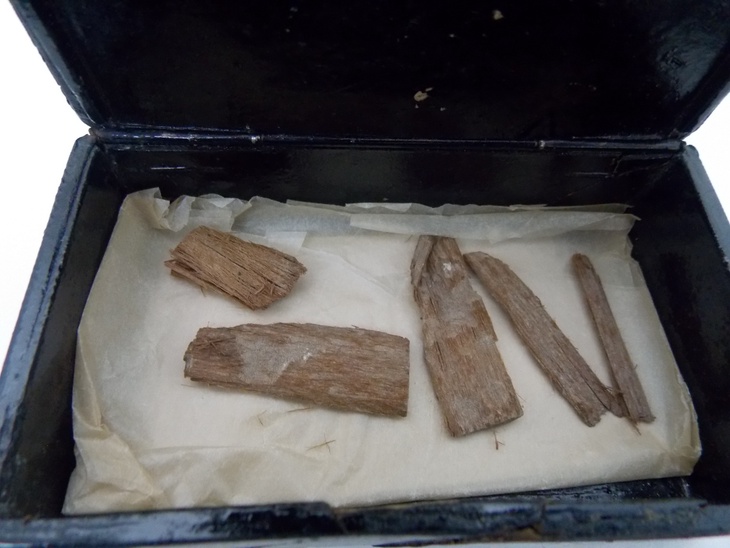
De houtfragmenten
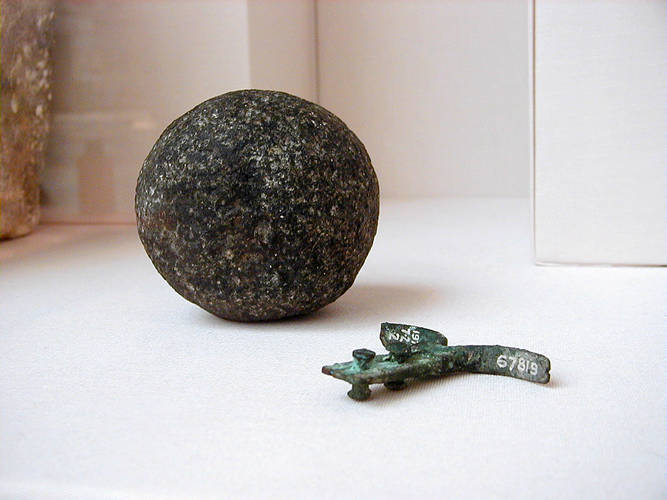
De overige ‘Dixon Relics’ (Wikimedia)
De houtfragmenten zijn inmiddels met C14-methodes gedateerd en blijken 5000 jaar uit te zijn. Dat is nog enkele honderden jaren ouder dan de piramide waarin ze zijn teruggevonden. Goed hout is schaars in Egypte. Werd het hout hergebruikt of ging het om een hele oude boom?
